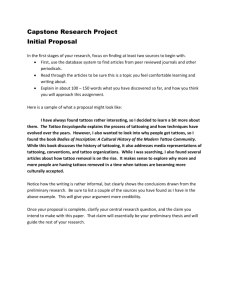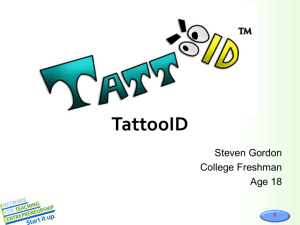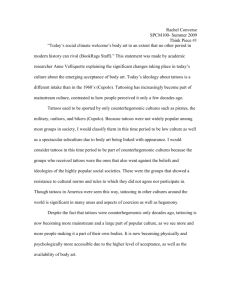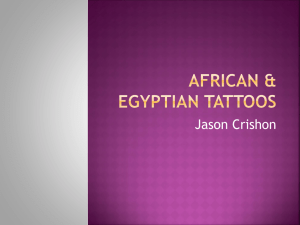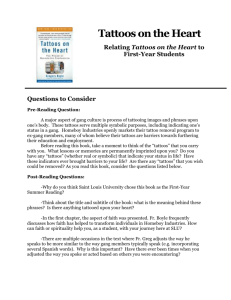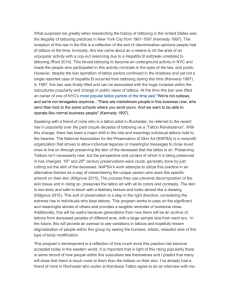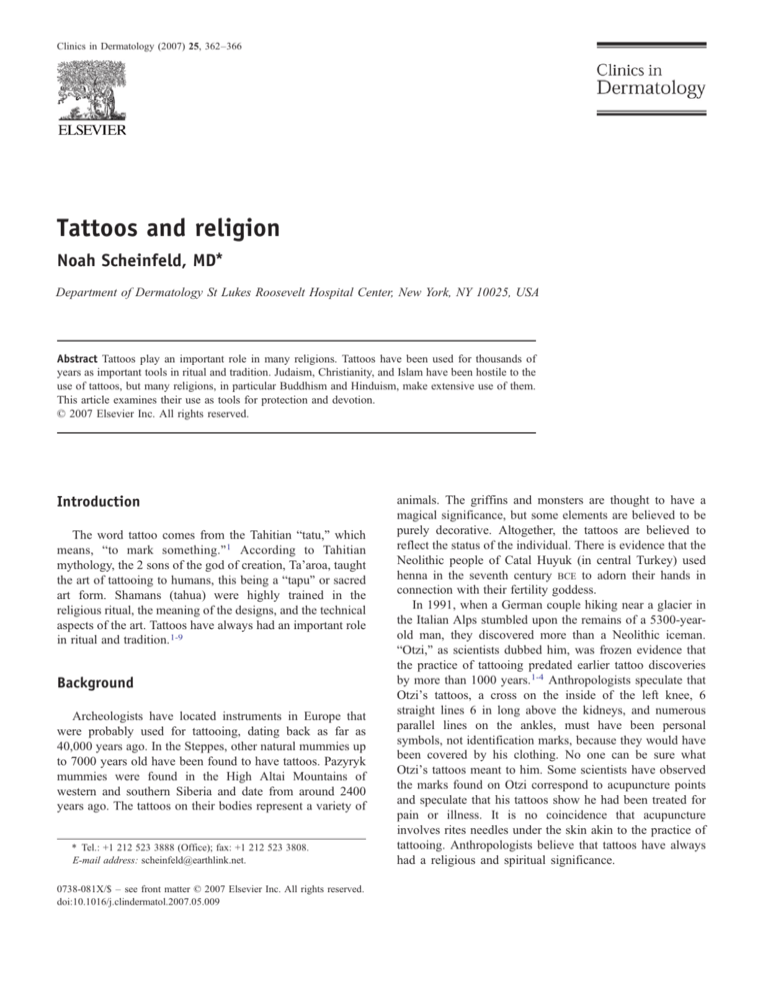
Clinics in Dermatology (2007) 25, 362–366
Tattoos and religion
Noah Scheinfeld, MD⁎
Department of Dermatology St Lukes Roosevelt Hospital Center, New York, NY 10025, USA
Abstract Tattoos play an important role in many religions. Tattoos have been used for thousands of
years as important tools in ritual and tradition. Judaism, Christianity, and Islam have been hostile to the
use of tattoos, but many religions, in particular Buddhism and Hinduism, make extensive use of them.
This article examines their use as tools for protection and devotion.
© 2007 Elsevier Inc. All rights reserved.
Introduction
The word tattoo comes from the Tahitian “tatu,” which
means, “to mark something.” 1 According to Tahitian
mythology, the 2 sons of the god of creation, Ta'aroa, taught
the art of tattooing to humans, this being a “tapu” or sacred
art form. Shamans (tahua) were highly trained in the
religious ritual, the meaning of the designs, and the technical
aspects of the art. Tattoos have always had an important role
in ritual and tradition.1-9
Background
Archeologists have located instruments in Europe that
were probably used for tattooing, dating back as far as
40,000 years ago. In the Steppes, other natural mummies up
to 7000 years old have been found to have tattoos. Pazyryk
mummies were found in the High Altai Mountains of
western and southern Siberia and date from around 2400
years ago. The tattoos on their bodies represent a variety of
⁎ Tel.: +1 212 523 3888 (Office); fax: +1 212 523 3808.
E-mail address: scheinfeld@earthlink.net.
0738-081X/$ – see front matter © 2007 Elsevier Inc. All rights reserved.
doi:10.1016/j.clindermatol.2007.05.009
animals. The griffins and monsters are thought to have a
magical significance, but some elements are believed to be
purely decorative. Altogether, the tattoos are believed to
reflect the status of the individual. There is evidence that the
Neolithic people of Catal Huyuk (in central Turkey) used
henna in the seventh century BCE to adorn their hands in
connection with their fertility goddess.
In 1991, when a German couple hiking near a glacier in
the Italian Alps stumbled upon the remains of a 5300-yearold man, they discovered more than a Neolithic iceman.
“Otzi,” as scientists dubbed him, was frozen evidence that
the practice of tattooing predated earlier tattoo discoveries
by more than 1000 years.1-4 Anthropologists speculate that
Otzi's tattoos, a cross on the inside of the left knee, 6
straight lines 6 in long above the kidneys, and numerous
parallel lines on the ankles, must have been personal
symbols, not identification marks, because they would have
been covered by his clothing. No one can be sure what
Otzi's tattoos meant to him. Some scientists have observed
the marks found on Otzi correspond to acupuncture points
and speculate that his tattoos show he had been treated for
pain or illness. It is no coincidence that acupuncture
involves rites needles under the skin akin to the practice of
tattooing. Anthropologists believe that tattoos have always
had a religious and spiritual significance.
Tattoos and religion
Egypt provides the earliest evidence of the earliest tattoos
during the time of the construction of the great pyramids.1–8
When the Egyptians expanded their empire, the art of
tattooing spread as well. The civilizations of Crete, Greece,
Persia, and Arabia picked up and expanded the art form.
Around 2000 BCE, tattooing spread to China.
It was once a very sacred and respected art; only the most
prestigious were privileged to adorn their bodies in such a
permanent way.
Judeo-Christian view of Tattoos 3
Judaism and Catholicism banned tattoos.3 This is based
on a single verse from Leviticus: “You shall not make any
cuttings in your flesh on account of the dead or tattoo any
marks upon you: I am the LORD.” Leviticus 19:28.
Christian tattoo opponents also like to stress these words
of St. Paul:
Do you not know that your body is a temple of the Holy
Spirit, who is in you, whom you have received from
God? You are not your own; you were bought at a price.
Therefore honor God with your body. (1 Corinthians
6:19-20)
This prohibition of tattoos is probably related to the use of
tattoos by religions that the Jews opposed, for example, the
cult of Baal, the Egyptian pantheon, and religions that the
Christians opposed, for example, the cult of Isis. In addition,
brand marks are what Roman slave owners tattooed on their
chattel slaves to display ownership, and early Christianity
found converts and support among Roman slaves.
There are references to body marking in the old and
new Testaments.
And it shall be to you as a sign on your hand and as a
memorial between your eyes, that the law of the LORD
may be in your mouth. (Exodus 13:9)
It shall be as a mark on your hand or frontlets between
your eyes; for by a strong hand the LORD brought us out
of Egypt. (Exodus 13:16)
363
Henceforth let no man trouble me; for I bear on my body
the brand marks of Jesus. (Galatians 6:17)
Then I saw another angel ascend from the rising of the
sun, with the seal of the living God, and he called with a
loud voice to the four angels who had been given power
to harm earth and sea, saying, ‘Do not harm the earth or
the sea or the trees, till we have sealed the servants of our
God upon their foreheads’. (Revelations 7:2-3)
On his robe and on his thigh he has a name inscribed,
King of kings and Lord of lords. (Revelations 19:16)
Despite these textual references, the Judeo-Christian
religions opposed tattoos. This is unsurprising as their
opponents, that is, idolaters, used tattoos in their worship.
There is a debate whether Christians are allowed to tattoo
themselves. In 787, the Council of Calcuth redefined the
church's policy on tattoos, and tattoos that were worn to
honor God and to bear witness to his glory were then said to
bring heavenly rewards.
Purposes of tattoos
Mark Hawthorne in the tale of Tattoos written for
Hinduism Today summarized the purposes of tattoos. His
discussion is reproduced with permission in a substantial
fashion in the following discussion on the purposes
of tattoos.1
Devotional tattoos
Religious tattoos possess dual modes that manifest
religious devotion. The first ordeal is the imprinting of the
tattoo, which is painful and seemingly endless, as particulate
matter is injected into the skin. The second ordeal involves
wearing the tattoo that is alteration of a person's visual
appearance that is wrapped up in the symbol, shape, form,
and design of the tattoo itself.
Ramnaamis
This one will say, ‘I am the LORD's,’ another will call
himself by the name of Jacob, and another will write on
his hand, ‘The Lord's,’ and surname himself by the name
of Israel. (Isaiah 44:5)
Behold, I have graven you on the palms of my hands;
your walls are continually before me. (Isaiah 49:16)
And the LORD said to him, ‘Go through the city,
through Jerusalem, and put a mark upon the foreheads of
the men who sigh and groan over all the abominations
that are committed in it’. (Ezekiel 9:4)
Among the most devoutly and uniformly tattooed sects in
the world are the Ramnaamis. Sparely populating the Indian
states of Bihar and Madhya Pradesh, the Ramnaamis are
members of the caste of untouchables. The Ramnaamis
believe that their tattoos furnish a refuge from harm in the
form of their distinctive tattoos, the name “Ram” repeated in
Sanskrit, which cover their bodies. These tattoos even appear
on their tongues and on the inside of their lips.
The Ramnaamis started their stunning and whole
encompassing practice at the time of the Hindu reformist
movement of the 19th century. At this time, the Ramnaamis
infuriated the upper-caste Brahmins by adopting brahminical
364
customs. To function as an aegis against the recriminations of
the Brahmins, the Ramnaamis tattooed the name of Lord
Ram over all skin areas. This has not been a totem against
harm, and the numbers of the Ramnaamis have dwindled.
There are only 1500 Ramnaamis left today. They still use
tattoos and apply them as did their forefathers. These tattoos
are as mush a demonstration of devotion as a talisman and a
totem against persecution and harm.
Hinduism whose polydeism and use of coloration and
physical transformation is perhaps the religion that most uses
tattoos today as tools of devotion. . Tattoos that picture the
major deities that include Siva, Ganesha, Lord Ram, Krishna,
and Kali are commonly used. Other tattoos replicate sacred
symbols like “Om.” Hindus and Buddists and others use the
Om, which is a scared word for Hindus and Buddists.
Among the most ornate tattoos in the world, the tattoos of
the women of the Ribari tribe of Kutch, the very region in
northwest India, stand out. The Kutch is a region in which
the Pandavas were exiled during the Mahabharata. The
Ribari are nomads. They use tattoos of the gods to reify their
devotional symbols on their bodies.
Tattoos and the afterlife
Other polydeists use tattoos. This was the case with the
indigenous peoples of the Pacific Islands and North America.
In New Zealand, the Maoris ardently thought that a spirit
would recognize their elaborate facial tattoos after they
passed to the portal of the next world. This spirit, the Maoris
thought, would give them the vision and the power for them
to find their way to the next world.
The Dayak tribes of Borneo thought their hand tattoos
give light in the night-like state of the hereafter. The Dayak
thought that their souls scoured for the river of the dead.
Maligang, the spirit guarding the river of the dead, would
check for the tattoo that gave to the soul the right to cross the
river of the dead.
In North America, the Lakota had a similar conception
of the role of tattoos and the afterlife. The lore of the
Lakota tradition noted that soul of the dead began its trek to
the next world on the starry spirit road (Milky Way). Along
the road, the soul had to cross in the path of the owl
woman. The owl woman scanned the soul of a Lakota for
its aspects of the tattoo. When the owl woman did not find
the tattoo that should have designated the Lakota, the soul
could not move forward.
The Inuits of Alaska applied tattoos in the rituals that
shaped them for their life in the next world. A trained shaman
placed small dots on the pallbearer at various joints along the
body to protect against evil spirits.
In a sense for many native peoples, the tattoos were brace,
a type of a touchstone that sustained the body's appearance
and integrity in the next world. That is, for these native
people, the body housed a soul, and with the tattoos, the body
could retain its appearance, tattoos and all after the expiration
of a person.
N. Scheinfeld
Other people did not think that tattoos allowed the body to
remain whole in the afterlife. Rather, these cultures thought
that death burned away the husk that is the flesh, and that the
tattoos were a kind of dog tag that provided the only form of
identification that would allow a soul to be identified.
Without the identification, which a tattoo provided, a soul
existing in a state beyond recognition would wander in the
afterworld finding no peace.
Tattoos for protection
Many cultures regard tattoos as protective totems, wards
against evil, and power amulets. These functions are linked
to magical powers attributed to the tattoos. In many cases, the
tattoos are at the center of religious rituals and tenets.
In Japan, the understanding that tattoos have power is
common. Ainu women, as an example, tattooed their bodies
with images of their goddess. The image of this goddess
possesses the power to cast out and keep away evil spirits. In
so doing, the goddess tattoo is an aegis from evil and disease.
This practice is even common in some places in the
Middle East, wherein the religion is Islamic. Iraqis in many
cases tattoo a dot at the tip of a youngster's nose to guard
against illness. Hindus use a tattoo of Hanuman to alleviate
them from pain and disease. Likewise, the Aborigines of
Australia think that tattoos on their limbs permit to dodge and
avoid boomerangs.
In Asia, the countries wherein Buddism was dominant
have a strong belief in the protective power of tattoo.
Soldiers in Myanmar (Burma) tattoo their thighs to be
invulnerable and as shield from the effects of battle.
Cambodian men encase their bodies in tattoos to make
themselves impervious to wounds, even from bullets, knives,
and missiles. Cambodian use of tattoos could have originated
from Indian settlers who practiced Vedic rituals or from
Buddhism itself. This idea that the tattoo can give a warrior
the quality of Achilles impervious to wounding is common
among subject people and has been used by guerilla and
rebel movements in situations where the American Indians
opposed United States forces, and among some Africans who
opposed their European colonial masters.
Sacred Buddhist texts commonly are tattooed to Thai
peoples. The texts are thought to possess power and magical
potency. In a Thai initiation rite called the “Krob Kru,” the
devotee offers up incense, a devotional offering, and prays to
become ready. The tattoo artist uses a special rod. The tattoo
artists etch the sacred text on to the torso and extremities. A
shaman at this time evaluates the tattoo's potency by
exposing each tattoo 3 or 4 strong sword blade swipes.
These Thai tattoo recipients can fall into a state of ecstasy or
burst into violent dream-like states or fervent trances.
The snake clan of Pakokku, Burma, has extensively
explicated protection tattoos. Over hundreds of years, these
Buddhist snake handlers have tattooed their bodies to shield
their persons against the poisonous snakes and cobras that
Tattoos and religion
live in the vicinity or are under their care. The snake clan of
Pakokku hold these deadly serpents, and potent snakes are
held in elevated regard. Buddhist legend recounts the tale of
a giant cobra sheltering a sleeping Lord Buddha during a
rainstorm. In the same vein, in Mandalay, there is a pagoda
that pays tribute to the snake. The snake clan of Pakokku
used the snake as fertility god. This is a small group because
only a few dozen of the snake clan of Pakokku still live in
Burma. They state that no one in the tribe has ever been
murdered by a viper. This is an astonishing fact because the
men of the snake clan of Pakokku are responsible for
capturing snakes by hand. Later, again by hand, the snakes
are set free unharmed kilometers from where they live.
The snake clan of Pakokku, Burma, believe that the tattoo
provides them with potent ability and secret power. Each
member of the snake clan of Pakokku partakes in weekly
tattooing, a ritual that involves prayer, a very large metal
needle, and black ink mixed with snake venom. The venom,
collected from vipers located in town, acts as an inoculation
and antidote against snakebite. The entire body is covered
with tattoos of Buddhist symbols. In every tattoo, there is
venom. Cobra venom is used for tattoos on the upper body.
Viper venom is used to prepare the tattoos for the lower body
to aid in fortifying the bearer's antibodies.
The Hawaiians worshipped specific tattoo Gods. Called
'aumakua, these family or personal gods can be protective
when properly honored. However, if the gods were not
obeyed or were ignored, they were destructive. In a fashion
akin to Native American spirit guides, the 'aumakua can take
the form of animals, inanimate objects, or even natural
phenomena, like lightning and thunder. Many Hawaiians
affix on their bodies special tattoos honoring their 'aumakua.
A tattooed row of dots around the ankle functions as a charm
against sharks. This is based on myth that recounts the tale of
a woman swimming in the ocean bitten by a shark. The teeth
touched her 'aumakua, and the shark saw this. When the
woman cried out, the shark freed her and noted, “I will not
make that mistake again, for I see the marks on your ankle.”
In Hawaii, the images of the tattoo gods possess a prominent
location in the places of tattoo priests and practitioners. Each
tattoo session starts with an invocation to the tattoo gods that
the etching of the tattoo will not cause injury, that the surgical
sites might heal soon, and that the designs might be pleasing
and attractive to the gods.
Samoa also has a rich tattoo tradition. “In ancient
Samoa, tattooing played an important role in both religious
ritual and warfare, ” writes Gilbert.6 “The tattoo artist held
a hereditary and privileged position. He customarily
tattooed young men in groups of six to eight, during a
ceremony attended by friends and relatives who participated in special prayers and celebrations associated with the
tattooing ritual.” The tattoos of Pacific Island natives made
an impact on English explorers, notably those who sailed
with Captain Cook late in the 18th century, and they
returned home with bold new designs and helped resurrect
the tattoo art in Europe.
365
Tattoo has an important role in religious life in Cambodia.
The following discussion is excerpted from the book,
Yantra et Mantra, by Olivier de Bernon, a member of the
Ecole Freançaise d'Extême-Orient. The book is published by
the French Cultural Center of Phnom Penh.9
The origin of the tattoo in Cambodia, however, can be
traced to Buddhist or Brahmanist formulas, or it could have
been inspired by the religion of errant hermits (“Muni EySey” in kmer). The use of magical implants in the body has in
existed in Cambodia for along time. In the 13th century, the
Chinese envoy Zhou Daguan wrote that the body of king
Jayavarrman, who was then the ruler of Angkor, “was inlaid
with a piece of sacred iron in such a way that even knives and
arrows, hitting his body, could not wound him.”
In a way that we have discussed above, the powerless use
tattoos to protect themselves from the potency and
ascendancy of their enemies. In the war against North
Vietnam, Khmer soldiers wore tattoos in the belief that they
had magical power to ward off misfortunes and bullets. Each
implant was made of a small blade of lead, silver, or gold, on
which was engraved yantras and which was then melted into
a small ball and introduced under the skin. Today, small
metallic strips, on which pali formulas are engraved on small
strings knotted and tied around the waist, replace them.
The origins of tattoo in Cambodia can be traced to the
northern Thais. However, it underwent transformation under
the Khmer civilization, the most significant change being the
adoption of the “round” Khmer alphabet (“Ak-sor mool”) for
the composition of the mantra.
In Cambodia, anyone who wears a tattoo has to be
initiated into the rites. The relationship between the master
(Krù in Khmer) and the disciple (Kohn Sèss in Khmer) is
intrinsic. The disciple or the person who wears the tattoos has
to strictly observe and follow closely all the rituals, rules, and
rites as stated by the master or the tattooed.
Tattooing rituals (“saek” In Khmer) take place where the
master lives: in a monastery if the master is a religious person
or in a private home if the master is a layperson. If the ritual is
performed at a home, an altar is set up, and the place is
consecrated: offerings of folded banana leaves of golden
papers. A total of 5 candles and 5 Buddha representing the
kalpa of 5 “elements,” that is, water, earth, fire, wind, and
space, are made.
Conclusions
Tattoos have helped people to remake themselves in their
eyes and in the eyes of their god or gods. Their totem
becomes part of a person and remakes the person into
something and someone new. The pain engendered by their
creation facilitates entrance into an initiated group. Their
appearance sets the wearer off from men who have not been
remade. The rise to dominance of the monotheistic faiths
Judaism, Christianity, and Islam lead to a decline in the use
of tattoos. For the Christians, even the act of circumcision,
366
which remakes a man, was to great a recasting for what God
had created. Although now tattoos are the purview of the
Japanese gangster, the Russian inmate, and the American
motorcycle user, tattoos have an ancient and holy history that
deserves and needs explication.
References
1. http://www.tattoos-by-design.co.uk/history.html.
2. http://tatthoo.com/tattoohistory1.htm.
N. Scheinfeld
3.
4.
5.
6.
http://www.religioustattoos.net/Bible_Support/index.php.
http://www.hinduismtoday.com/archives/2001/7-8/38-41_tatoo.shtml.
Gilbert S. The tattoo history source book. New York: Juno Books; 2000.
Rush JA. Spiritual Tattoo: A Cultural History of Tattooing, Piercing,
Scarification, Branding, and Implants. Berkeley (Calif): Frog; 2005
[Distributed by North Atlantic Books].
7. Wroblewski C. Skin shows: the tattoo bible. Wingfield, S.A.: Cameron
House; 2004
8. Caplan J. Written on the body: the tattoo in European and American
history. Princeton New Jersey: Princeton University Press; 2000.
9. de Bernon O. Yantra and Mantra, text and photographs, préf. of Mr. Heng
Samrin, Phnom Penh, Arts centre and of linguistic co-operation (French
Cultural Center of Phnom Penh), Phnom Penh, Cambodia; 1998.

